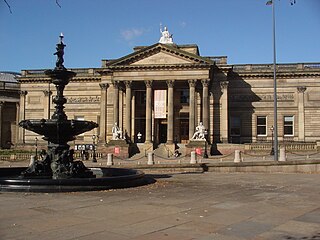
The Walker Art Gallery is an art gallery in Liverpool, which houses one of the largest art collections in England outside London. It is part of the National Museums Liverpool group.
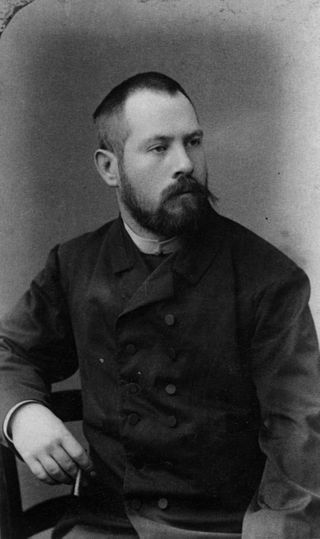
Lovis Corinth was a German artist and writer whose mature work as a painter and printmaker realized a synthesis of impressionism and expressionism.

Giovanni Segantini was an Italian painter known for his large pastoral landscapes of the Alps. He was one of the most famous artists in Europe in the late 19th century, and his paintings were collected by major museums. In later life, he combined a Divisionist painting style with Symbolist images of nature. He was active in Switzerland during the last period of his life.
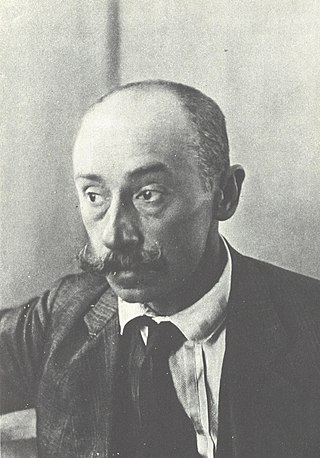
Konstantin Fyodorovich Bogaevsky was a Ukrainian and Russian painter from Crimea, notable for his Symbolist landscapes.
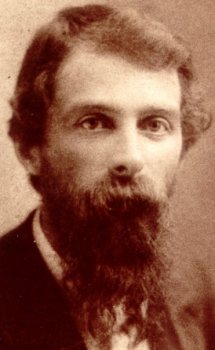
Giuseppe Pellizza da Volpedo was an Italian Divisionist painter. Pellizza was a pupil of Pio Sanquirico. He used a Divisionist technique in which a painting is created by juxtaposing small dots of paint according to a specific colour theory. Although he exhibited often, his work achieved popularity in death through their reproduction in socialist magazines and the acclaim they received from 20th-century art critics.

Giovanni Ulrico Giacometti was a Swiss painter. He was the father of artists Alberto and Diego Giacometti and architect Bruno Giacometti.

Emilio Longoni was an Italian painter.

Giovanni Migliara (October 15, 1785 in Alessandria – April 18, 1837 in Milan), was a nobleman and Italian painter active at the beginning of the 19th century, painting vedute and history paintings.

Emanuel Božidar Vidović was a Croatian painter and graphic artist from Split.
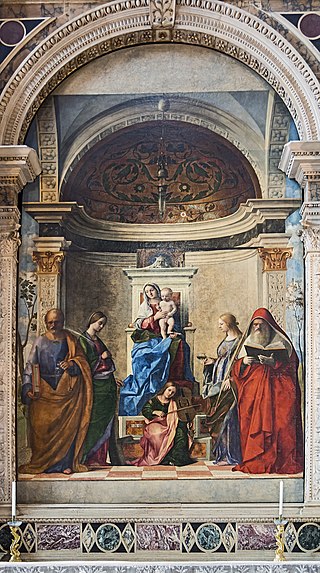
The San Zaccaria Altarpiece is a painting by the Italian Renaissance painter Giovanni Bellini, executed in 1505 and located in the church of San Zaccaria, Venice.

Vittore Grubicy de Dragon was an Italian painter, art critic and art gallery owner who was largely responsible for introducing into Italian painting the optical theories of Divisionism. His writings and paintings influenced a generation of late 19th-century Italian painters. In addition, the Grubicy Gallery became one of the first art enterprises to be run on the concept of exhibiting living artists that were represented as clients of the gallery.

Cesare Maggi was an Italian painter.

The Galleria d'Arte Moderna is a modern art museum in Milan, in Lombardy in northern Italy. It is housed in the Villa Reale, at Via Palestro 16, opposite the Giardini Pubblici Indro Montanelli. The collection consists largely of Italian and European works from the eighteenth to the twentieth centuries.
Giovanni Battista Ciolina was an Italian neo-impressionist and divisionist painter.

Girl Running on a Balcony is a 1912 painting by Giacomo Balla, one of the forerunners of the Italian movement called Futurism. The piece indicates the artist's growing interests in creative nuances which would later formally be realized as part of the Futurist movement. The artist was heavily influenced by northern Italians' use of Divisionism and the French's better-known pointillism. Created with oil on canvas just on the brink of World War I, the Futurist movement is embodied by a dark optimism for a future of speed, turbulence, chaos, and new beginnings. Most of Giacaomo Balla's pieces allude to the wonder of dynamic movement, and this painting is no exception. The oil painting is now in the Museo del Novecento, in Milan.
Carlo Fornara was an Italian neo-impressionist and divisionist painter.

Beware of Luxury is a 1663 oil painting by the Dutch painter Jan Steen, now in the Kunsthistorisches Museum in Vienna.

Love at the Fountain of Life or The Lovers at the Fountain of Life is an 1896 oil on canvas painting by Giovanni Segantini, commissioned by prince Yusupov of Saint Petersburg during the artist's mature period and one of the most famous works of his Symbolist period, which had begun in 1891 with The Bad Mothers. It is signed in red at bottom left "G. Segantini - Maloja 1896". It is now in the Galleria d'Arte Moderna, in Milan, to which it was bequeathed in 1955.
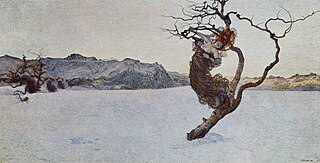
The Bad Mothers or The Evil Mothers is an oil on canvas painting by Giovanni Segantini, created in 1894, now in the Österreichische Galerie Belvedere, in Vienna. It is the last of four works in which he keeps returning to the motif of women in trees. The other three were The Fruit of Life (1889), The Punishment of Lust (1891) and The Angel of Life (1894), and together, they were his first Symbolist works.
The Punishment of Luxury may refer to:

















